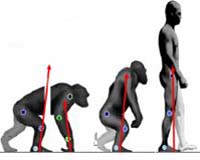 |
Munich, Germany (SPX) Nov 09, 2010 The brains of newborn humans and Neanderthals are about the same size and appear rather similar overall. It's mainly after birth, and specifically in the first year of life, that the differences between our brains and those of our extinct relatives really take shape, according to a report published in Current Biology. The findings are based on comparisons of virtual imprints of the developing brain and surrounding structures (known as endocasts) derived from the skulls of modern and fossilized humans, including that of a newborn Neanderthal. Philipp Gunz of the Max Planck Institute for Evolutionary Anthropology explained that the differences researchers observe in early brain development likely reflect changes in the underlying brain circuitry. It is that internal organization of the brain that matters most for cognitive ability. "In modern humans, the connections between diverse brain regions that are established in the first years of life are important for higher-order social, emotional, and communication functions," Gunz said. "It is therefore unlikely that Neanderthals saw the world as we do." Whether cognitive differences exist between modern humans and Neanderthals is the subject of contentious disputes in anthropology and archaeology, he said. Because the range of brain sizes in Neanderthals overlaps with humans, many researchers had assumed that the cognitive capabilities of the two species were similar. The new findings challenge that notion. In fact, the elongated overall shape of the braincase hasn't changed much in the course of more than two million years of human evolution, despite a big increase in endocranium volume. It is the globular braincases of modern humans that distinguish our own species from our closest fossil relatives and ancestors. The new results show that, at the time of birth, both Neanderthals and modern humans have elongated braincases, but only modern human endocasts change to a more globular shape in the first year of life. "The distinct globular braincase shape of adult humans is therefore largely the result of an early brain development phase that is absent from Neanderthals," Gunz said. The research team had earlier found that the developmental patterns of chimpanzee and human brains are remarkably similar after the first year of life but differ markedly immediately after birth. The new findings therefore show that the "globularization phase" of brain development distinguishes modern humans not only from chimpanzees, but also from Neanderthals. This new view on human brain development might shed light on the results of a recent comparison of Neanderthal and modern human genomes, according to the researchers. "The uniquely modern pattern of early brain development is particularly interesting in the light of the recent breakthroughs in the Neanderthal genome project, which identified genes relevant to cognition that are derived in living humans," the researchers wrote. "We speculate that a shift away from the ancestral pattern of brain development occurring in early Homo sapiens underlies brain reorganization and that the associated cognitive differences made this growth pattern a target for positive selection in modern humans."
Share This Article With Planet Earth
Related Links Max Planck Institute for Evolutionary Anthropology All About Human Beings and How We Got To Be Here
 New Statistical Model Moves Human Evolution Back Three Million Years
New Statistical Model Moves Human Evolution Back Three Million YearsOxford, UK (SPX) Nov 08, 2010 Evolutionary divergence of humans from chimpanzees likely occurred some 8 million years ago rather than the 5 million year estimate widely accepted by scientists, a new statistical model suggests. The revised estimate of when the human species parted ways from its closest primate relatives should enable scientists to better interpret the history of human evolution, said Robert D. Martin, c ... read more |
|
| The content herein, unless otherwise known to be public domain, are Copyright 1995-2010 - SpaceDaily. AFP and UPI Wire Stories are copyright Agence France-Presse and United Press International. ESA Portal Reports are copyright European Space Agency. All NASA sourced material is public domain. Additional copyrights may apply in whole or part to other bona fide parties. Advertising does not imply endorsement,agreement or approval of any opinions, statements or information provided by SpaceDaily on any Web page published or hosted by SpaceDaily. Privacy Statement |